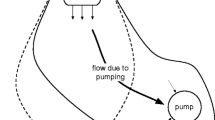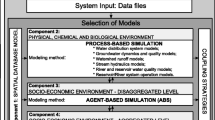Abstract
While technical tools for analysis of water resources systems have advanced, the major issue in resolving problems focuses on the interaction of human and natural systems. Agent-based modeling (ABM) has recently been used as an effective tool to develop integrated human-environmental models. One of the main challenges of ABM application in water resources management is to identify and characterize key agents. We provided recommendations to characterize agents normally involved in water decisions, and developed a framework for a conflict management tool, comprised of three models: a watershed simulation, an optimization, and a behavioral simulation model. The optimization-simulation model determined tradeoffs between the objective functions. The behavioral simulation model, developed based on ABM, simulated stakeholders interactions and their reactions to water allocation decisions. This model evaluated the applicability of different management scenarios to achieve specific rates of reduction in agricultural water allocations, selected from the tradeoffs. To develop and adjust this model, key stakeholders were identified in the San Joaquin River (SJR) watershed, California, and a survey was administered. The proposed recommendations and framework provides a new and innovative way to identify institutional interconnections, formulate and simulate their interactions, and create a hydrologic-environmental-human interface to support powerful decision-support tools to manage conflicts and make informed, practical decisions in water resources.




Similar content being viewed by others
References
Akhbari M (2012) Models for management of water conflicts: a case study of the San Joaquin Watershed, California. PhD, Colorado State University
Akhbari M, Grigg NS (2013) A framework for an agent-based model to manage water resources conflicts. Water Resour Manag 27:4039–4052. doi:10.1007/s11269-013-0394-0
Akhbari M, Grigg NS (2014) Water management tradeoffs between agriculture and the environment: a multiobjective approach and application. J Irrig Drain Eng 140 doi: 10.1061/(ASCE)IR.1943-4774.0000737
Bandini S, Manzoni S, Vizzari G (2009) Agent based modeling and simulation: an informatics perspective. Jasss-J Artif Soc Simul 12:A51–A66
Barthel R, Janisch S, Nickel D, Trifkovic A, Horhan T (2010) Using the multiactor-approach in Glowa-Danube to simulate decisions for the water supply sector under conditions of global climate change. Water Resour Manag 24:239–275. doi:10.1007/s11269-009-9445-y
Berger T, Birner R, Diaz J, McCarthy N, Wittmer H (2007) Capturing the complexity of water uses and water users within a multi-agent framework. Water Resour Manag 21:129–148. doi:10.1007/s11269-006-9045-z
Bonabeau E (2002) Agent-based modeling: methods and techniques for simulating human systems. Proc Natl Acad Sci U S A 99:7280–7287. doi:10.1073/pnas.082080899
Bousquet F, Le Page C (2004) Multi-agent simulations and ecosystem management: a review. Ecol Model 176:313–332. doi:10.1016/j.ecolmodel.2004.01.011
Brooks RA (1986) A robust layered control-system for a mobile robot. IEEE Trans Robot Autom 2:14–23. doi:10.1109/Jra.1986.1087032
Edwards M, Ferrand N, Goreaud F, Huet S (2005) The relevance of aggregating a water consumption model cannot be disconnected from the choice of information available on the resource. Simul Model Pract Theory 13:287–307. doi:10.1016/j.simpat.2004.11.008
Galan JM, Lopez-Paredes A, del Olmo R (2009) An agent-based model for domestic water management in Valladolid metropolitan area. Water Resour Res 45, W05401. doi:10.1029/2007wr006536
Gilbert N, Troitzsch KG (1999) Simulation for the social scientist. Open University Press, Buckingham
Grober LF (1996) Sources and circulation of salt in the SJR basin. In: Bathala C (ed) North American water and environmental congress 1996. American Society of Civil Engineers, Environmental Engineering Division, Orange County, pp 54–59
Hashimoto T, Stedinger JR, Loucks DP (1982) Reliability, resiliency, and vulnerability criteria for water-resource system performance evaluation. Water Resour Res 18:14–20. doi:10.1029/Wr018i001p00014
Herr JW, Chen CW (2007) SJR up-stream DO TMDL project - Task 6. San Joaquin Valley Drainage Authority
Kock BE (2008) Agent-based models of socio-hydrological systems for exploring the institutional dynamics of water resources conflict. Massachusetts Institute of Technology
Kratzer CR, Grober LF (1991) SJR salinity: 1991 projections compared to 1977. Calif Agric 45:24–27. doi:10.3733/ca.v045n06p24
Loucks DP (1990) Analytical aids to conflict management. In: Viessman W, Smerdon ET (eds) Managing water-related conflicts: the Engineers role. ASCE, NY, pp 23–37
Macal CM, North MJ (2006) Tutorial on agent-based modeling and simulation part 2: How to model with agents Proceedings of the 2006 Winter Simulation Conference, 1–5:73–83. doi: 10.1109/Wsc.2006.323040
Macy MW, Willer R (2002) From factors to actors: computational sociology and agent-based modeling. Annu Rev Sociol 28:143–166. doi:10.1146/annurev.soc.28.110601.141117
Nikolic VV, Simonovic SP, Milicevic DB (2013) Analytical support for integrated water resources management: a new method for addressing spatial and temporal variability. Water Resour Manag 27:401–417. doi:10.1007/s11269-012-0193-z
Peterson DH, Cayan DR, Dettinger MD et al (1996) San Francisco bay salinity: observations, numerical simulation, and statistical models. In: Hollibaugh JT (ed) San Francisco bay: the ecosystem. American Association for the Advancement of Science, San Francisco, pp 9–34
Pitzer G (2009) Salinity in the Central Valley: A critical problem. Aquafornia, Water Education Foundation. http://www.aquafornia.com/index.php/about/. Accessed 12/12/2013
Renofalt BM, Jansson R, Nilsson C (2010) Effects of hydropower generation and opportunities for environmental flow management in Swedish riverine ecosystems. Freshw Biol 55:49–67. doi:10.1111/j.1365-2427.2009.02241.x
Sheikh PA, Cody BA (2005) CALFED Bay-delta program: overview of institutional and water use issues. CRS Report for Congress
Soman S, Misgna G, Kraft SE, Lant C, Beaulieu JR (2008) An agent-based model of multifunctional agricultural landscape using genetic algorithms. In: 2008 Annual Meeting, Orlando, Florida 6142, American Agricultural Economics Association, July 27-29, 2008
Tamene L, Le QB, Vlek PLG (2014) A landscape planning and management tool for land and water resources management: an example application in Northern Ethiopia. Water Resour Manag 28:407–424. doi:10.1007/s11269-013-0490-1
US Department of Agriculture (2009) Trade and agriculture: what’s at stake for California? http://www.fas.usda.gov/info/factsheets/wto/states/ca.pdf
Wolf AT (2008) Healing the enlightenment rift: rationality, spirituality and shared waters. J Int Aff 6:51–73. doi:10.1007/s11069-006-9094-x
Yang YCE, Cai XM, Stipanovic DM (2009) A decentralized optimization algorithm for multiagent system-based watershed management. Water Resour Res 45 doi: 10.1029/2008wr007634
Young HP (1999) Diffusion in social networks, Working paper. Brookings Institute:Washington, D.C.
Yuan XC, Wei YM, Pan SY, Jin JL (2014) Urban household water demand in Beijing by 2020: an agent-based model. Water Resour Manag 28:2967–2980. doi:10.1007/s11269-014-0649-4
Zechman EM (2011) Agent-based modeling to simulate contamination events and evaluate threat management strategies in water distribution systems. Risk Anal 31:758–772. doi:10.1111/j.1539-6924.2010.01564.x
Author information
Authors and Affiliations
Corresponding author
Appendix
Appendix
The objective function in Akhbari and Grigg 2014 was defined to maximize the outflow and minimize the salinity load to the Delta, while maximizing agricultural water allocations. Constraints were restricting excessive water allocation to agricultural fields and meeting environmental flow requirements. We determined the tradeoffs between these objectives using a genetic algorithm model, linked to a watershed simulation model. Then, we selected some tradeoff points for further investigations. Table 4 presents these points along with their corresponding values on the objective functions.
Rights and permissions
About this article
Cite this article
Akhbari, M., Grigg, N.S. Managing Water Resources Conflicts: Modelling Behavior in a Decision Tool. Water Resour Manage 29, 5201–5216 (2015). https://doi.org/10.1007/s11269-015-1113-9
Received:
Accepted:
Published:
Issue Date:
DOI: https://doi.org/10.1007/s11269-015-1113-9




